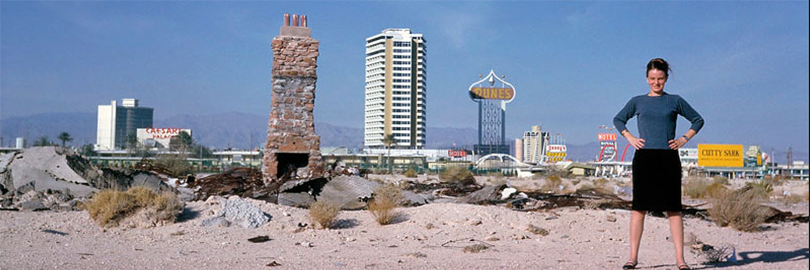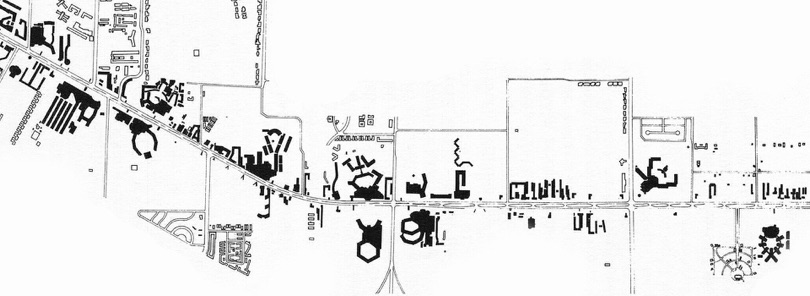Box 2: Las Vegas and Le Corbusier
Page 17
Box 2: Las Vegas and Le Corbusier
Page 18
In their book Learning From Las Vegas, 1977, the authors took a clear stand against the idea of modern space virtually calling it Anti-Space.
“Perhaps the most tyrannical element in architecture now is space. Space has been contrived by architects and deified by critics, filling the vacuum created by fugitive symbolism”.
At the same time, they also admired the desert version of this same space found along and behind the main highway strip (B2-a,b). Their primary criticism of Modern Architecture was its rejection of symbolic form and the elimination of ornament, but the deified exclusivity of its space was also a liability. As they say about Le Corbusier: “In the architecture of abstract expressionism, space is what displaced symbolism”.
Venturi’s affirmation of the unique expressionless, but all encompassing, qualities of Modern space is quite clear and correct. However, because Le Corbusier does not describe Modern space specifically, it is also possible to misinterpret his statement as a rejection of all types of space. This implies an inherent opposition: architecture is a question of signs versus space, but empty space is what both Le Corbusier and Venturi had in mind, not figural space deliberately formed. Figural space, because it has form, can be symbolic and carry meaning in itself.
Although the continued deference to Modern space is rightly criticized by Venturi as tyrannical, when this same type of space is discovered in the open context of Las Vegas, it is embraced as an acceptable phenomenon with a legitimate historical pedigree.
“The A&P parking lot is a current phase in the evolution of vast space since Versailles. The space that divides high-speed highways and low, sparse buildings produces no enclosure and little direction. To move through this landscape is to move over vast expansive texture.”
The Highway Strip and Modern Architecture
View of Las Vegas, Nevada, from Learning from Las Vegas, by Robert Venturi, Denise Scott Brown and Steven Izenour, 1977.
Figure-ground plan of main strip, Las Vegas, Nevada, from Learning from Las Vegas, by Robert Venturi, Denise Scott Brown and Steven Izenour, 1977.

Click image for larger version
This vast expansive texture of space discovered at Las Vegas in 1977 is the same vast Modern space used as the pervasive unifying abstraction for Le Corbusier’s Antwerp plan in 1933. As one can see in the two comparable wide views of each place (B2-a,c). This is the dilemma that architecture and urbanism must face. Anti-Space is not friendly. It has a placeless melancholy and alienation built into it.
However, this is not inevitable. There are not one, but at least two kinds of space. This one: vast, expansive, and homogeneous is imagined as an inevitable progress toward historical truth, “A current phase in the evolution of vast space since Versailles” — the other: its opposite, bounded, configured, and heterogeneous, is a deliberate aesthetic invention with the potential for its own symbolism, complexities and contradictions.
If the overall space of Las Vegas, like the vast expanse of suburban sprawl, is really the same space as Le Corbusier’s modern city, this is the unchallenged assumption which should not pass without criticism. Compare the site plans, drawn to the same scale, of Le Corbusier’s 1945, post-war rebuilding project for the small town of Saint-Dié, France and the main intersection in Las Vegas, Nevada in 1977 (B2-d). Each of the four casinos is a self sufficient crawling organism bigger than the pure slabs and boxes of the geometrically ordered town center at Saint-Dié, but in both cases the architecture sits alone disconnected in empty space. The casinos’ enclosed private pool areas attached at the back of each complex indicate the realistic need for an enclosing architecture of space.
Without reconsidering the definition of architectural and urban Space, the highway strip, suburban sprawl, “A&P parking lots”, and the destruction of the city will continue. All are direct consequences of this “tyrannical element” or, Anti-Space, which has become the uncritical dominating presence of the contemporary environment.
B2-c View of Le Corbusier’s Plan for Antwerp, 1933.
Figure-ground drawings of city plans were first done by Wayne Copper in Colin Rowe’s Urban Design Studio at Cornell.
Interestingly, “Corbu” never drew traditional solid/void city plans, because they would look too empty. He always used shadow plans with lots of trees and dark grass to fill up the emptiness.
Figure-ground plan of Saint-Dié, France, Le Corbusier, 1951 (by Wayne Copper, bottom), compared to the main intersection in Las Vegas (by Venturi, Scott Brown, top).



B2-a
B2-b
B2-d
